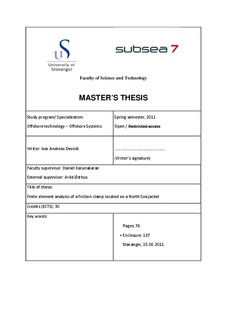| dc.contributor.author | Devold, Ivar Andreas | |
| dc.date.accessioned | 2011-10-21T13:12:48Z | |
| dc.date.available | 2011-10-21T13:12:48Z | |
| dc.date.issued | 2011 | |
| dc.identifier.uri | http://hdl.handle.net/11250/182833 | |
| dc.description | Master's thesis in Offshore technology | en_US |
| dc.description.abstract | This master thesis is written on the University of Stavanger spring 2011 in collaboration with Subsea 7. When transporting hydrocarbons from seabed to top side on a jacket platform there is always the need of a riser. Risers are attached to the platform leg or bracing by means of riser clamps. The riser loads together with environmental forces transfers large stresses to the clamps. To ensure that the clamps can withstand these loads over the design life, several analyses have to be performed. This thesis covers the design methodology and the most important analyses using a FE (Finite Element) tool, on one of the clamps designed by Subsea 7 for the Ekofisk 2/4-B platform.
Basically three analyses are performed; ULS (Ultimate Limit State) stress check and FLS (Fatigue Limit State) check for the clamp and the bolts, in addition to a non-linear slippage analysis. The action loads from the riser are given by the jacket operator. The environmental forces on the riser and the clamps are calculated to find the largest load combination in the horizontal- and vertical direction. For the various analyses different load- and material factors are applied to the forces. The worst load combination is applied in the analysis which is conducted in ANSYS, FE tool. The linear FE analysis has to be setup correctly to obtain good results.
The results for the ULS stress check are in general within allowable limits, i.e. below design yield. There is however some peak stresses in local areas that are above design yield. Common practice is to conduct a non-linear analysis and check if the peak stresses are due to secondary effects. To disregard the secondary effects the plastic strain obtained in the non-linear analysis have to be insignificant. The results obtained indicate that the peak stresses are due to secondary effects, hence the clamp meets the requirements for the ULS criteria.
In the FLS check three hot spots is checked including a weld. Stress ranges are obtained from the cyclical loads and the number of cycles during the design life calculated. The fatigue damage factor found shall not exceed the fatigue utilization factor calculated for the clamp. This ensures that the clamp will avoid fatigue damage in the design life. It is shown that welds are more fragile to fatigue than plated structures. Regardless all the hot spots are within allowable limits.
The slippage analysis is performed to find out if there is enough statically friction force in the riser clamp to avoid the clamp from sliding. The clamping force is depended of the bolt pre-tension. Too much tension can cause to high pressure on the jacket leg causing it to buckle and too low tension can cause the clamp to slip. The results show that there are sufficient sticking elements in the clamp to avoid slippage. | en_US |
| dc.description.sponsorship | Subsea 7 | en_US |
| dc.language.iso | eng | en_US |
| dc.publisher | University of Stavanger, Norway | en_US |
| dc.relation.ispartofseries | Masteroppgave/UIS-TN-IKM/2011; | |
| dc.subject | offshore teknologi | en_US |
| dc.subject | undervannsteknologi | en_US |
| dc.title | Finite element analysis of a friction clamp located on a North Sea jacket | en_US |
| dc.type | Master thesis | en_US |
| dc.subject.nsi | VDP::Technology: 500::Marine technology: 580 | en_US |
